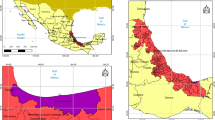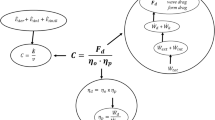Summary
-
1.
At ambient temperatures (T a) between 39 and 43°C, specimens of the waterproof treefrogChiromantis xerampelina, resting quietly in wind tunnels, adjust rates of evaporative water loss (EWL), maintaining body temperature (T b) 2–4°C belowT a.
-
2.
Brain heating and cooling, respectively, increased and decreased steady-state rates of thermoregulatory evaporative water loss (EWL), driving negative feedback changes inT b.
-
3.
Continuous infusions of epinephrine resulted in specific, dose-dependent, saturable increases in EWL; isoproterenol was more potent than epinephrine, which was more potent than phenylephrine. Tyramine injection also stimulated EWL.
-
4.
Non-specific increases in EWL stimulated by injections of cholinergic agonists were weakly antagonized by atropine, but thermally induced EWL, as well as adrenergically and cholinergically stimulated increases in EWL, were abolished by beta-adrenergic antagonists.
-
5.
Sweating decreased andT b increased during ganglionic blockade.
-
6.
The observations suggest thatC. xerampelina controls thermoregulatory EWL by modulating the sympathetic nervous outflow stimulating beta-adrenergic receptors on cutaneous mucous glands.
Similar content being viewed by others
Abbreviations
- EWL :
-
evaporative water loss
- T b :
-
body temperature
- T a :
-
ambient temperature
- T brain :
-
brain temperature
- ACh :
-
acetylcholine
References
Adolph EF (1933) Exchanges of water in the frog. Biol Rev 8:224–240
Azuma T, Binia A, Visscher MB (1965) Adrenergic mechanisms in the bullfrog and turtle. Am J Physiol 209:1287–1294
Brattstrom BH (1963) Thermal requirements of amphibians. Ecology 44:238–255
Brattstrom BH (1970) Amphibia. In: Whittow CG (ed) Comparative physiology of thermoregulation (vol 1). Academic Press, New York, pp 333
Duellman WE, Trueb L (1986) Biology of amphibians. McGraw-Hill, New York, pp 670
Drewes RC, Hillman SS, Putnam RW, Sokol DM (1977) Water, ion and nitrogen balance in the treefrog,Chiromantis petersi, with comments on the structure of the integument. J Comp Physiol 116:257–267
Duclaux R, Fantino M, Cabanac M (1973) Comportement thermoregulateur chezRana esculenta. Influence du rechauffement spinal. Pflügers Arch Eur J Physiol 342:347–358
Geise W, Linsenmair KE (1986) Adaptations of the reed frogHyperolius viridiflavus (Amphibia, Anura, Hyperoliidae) to its arid environment. II. Some aspects of the water economy ofHyperolius viridiflavus nitidulus under wet and dry season conditions. Oecologia 68:542–548
Hammel HT (1983) Phylogeny of regulatory mechanisms in temperature regulation. J Thermal Biol 8:37–42
Lillywhite HB (1971) Thermal modulation of cutaneous mucous discharge as a determinant of evaporative water loss in the frog,Rana catesbeiana. Z Vergl Physiol 73:84–104
Lillywhite HB (1974) Physiological correlates of basking in amphibians. Comp Biochem Physiol 52A:223–230
Loewi O (1936) Quantitative and qualitative Untersuchungen über den Sympaticusstoff. Pflügers Arch Ges Physiol 237:504–514
Loveridge JP (1970) Observations on nitrogenous excretion and water relations ofChiromantis xerampelina (Amphibia, Anura). Arnoldia (Rhodesia) 5:1–6
McClanahan LL, Stinner JN, Shoemaker VH (1978) Skin lipids, water loss and energy metabolism in a South American tree frog (Phyllomedusa sauvagei). Physiol Zool 51:179–187
Myhre K, Cabanac M, Myhre G (1977) Fever and behavioral temperature regulation in the frogRana esculenta. Acta Physiol Scand 101:219–229
Rey P (1937) Recherches experimentales sur l'economie de l'au chez les Batraciens. Ann Physiol Physiochem Biol 13:1081–1144
Shoemaker VH (1988) Physiological ecology of amphibians in arid environments. J Arid Environ 14:145–153
Shoemaker VH, McClanahan LL Jr (1975) Evaporative water loss, nitrogen excretion and osmoregulation in phyllomedusine frogs. J Comp Physiol 100:331–335
Shoemaker VH, Balding D, Ruibal R, McClanahan LL Jr (1972) Uncotelism and low evaporative water loss in a South American frog. Science 175:1018–1020
Shoemaker VH, McClanahan LL, Withers PC, Hillman SS, Drewes RC (1987) Thermoregulatory response to heat in the waterproof frogsPhyllomedusa andChiromantis. Physiol Zool 60:365–372
Shoemaker VH, Baker MA, Loveridge JP (in press) Effect of water balance on thermoregulation in waterproof frogs (Chiromantis andPhyllomedusa). Physiol Zool 62
Sjöberg E, Flock Å (1976) Innervation of skin glands in the frog. Cell Tissue Res 172:81–91
Taylor P (1980) Cholinergic agonists. In: Gilman AG, Goodman LS, Gilman A (eds) The pharmacological basis of therapeutics, 6th edn. Macmillan, New York
Tracy CR (1976) A model of the dynamic exchanges of water and energy between a terrestrial amphibian and its environment. Ecol Monogr 46:293–326
Watlington CO, Huff EG (1971) β-adrenergic stimulation of frog skin mucous glands: non-specific inhibition by adrenergic blocking agents. Comp Gen Pharmacol 2:295–305
Weiner N (1980a) Atropine, scopolamine, and related antimuscarinic drugs. In: Gilman AG, Goodman LS, Gilman A (eds) The pharmacological basis of therapeutics, 6th edn. Macmillan, New York
Weiner N (1980b) Drugs that inhibit adrenergic nerves and block adrenergic receptors. In: Gilman AG, Goodman LS, Gilman A (eds) The pharmacological basis of therapeutics, 6th edn. Macmillan, New York
Withers PC, Louw G, Nicholson S (1982) Water loss and nitrogen excretion in sharp-nosed reed frogs (Hyperolius nasatus: Anura, Hyperoliidae). J Exp Biol 97:335–343
Author information
Authors and Affiliations
Rights and permissions
About this article
Cite this article
Kaul, R., Shoemaker, V.H. Control of thermoregulatory evaporation in the waterproof treefrogChiromantis xerampelina . J Comp Physiol B 158, 643–649 (1989). https://doi.org/10.1007/BF00693002
Accepted:
Issue Date:
DOI: https://doi.org/10.1007/BF00693002




